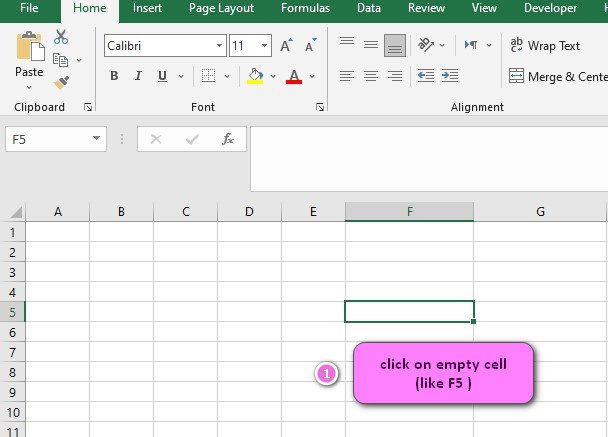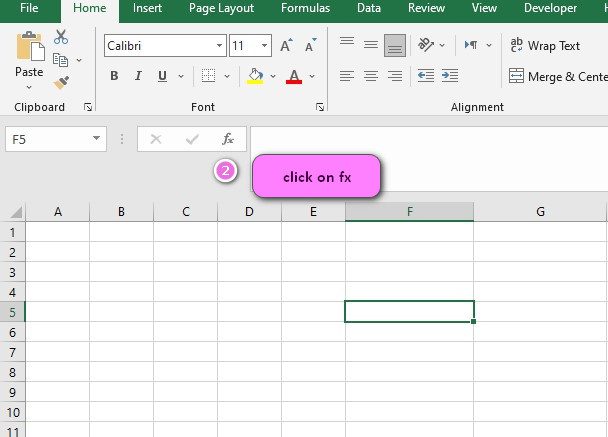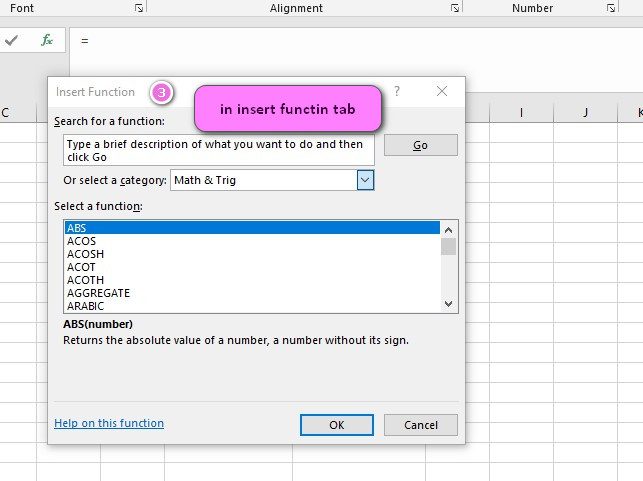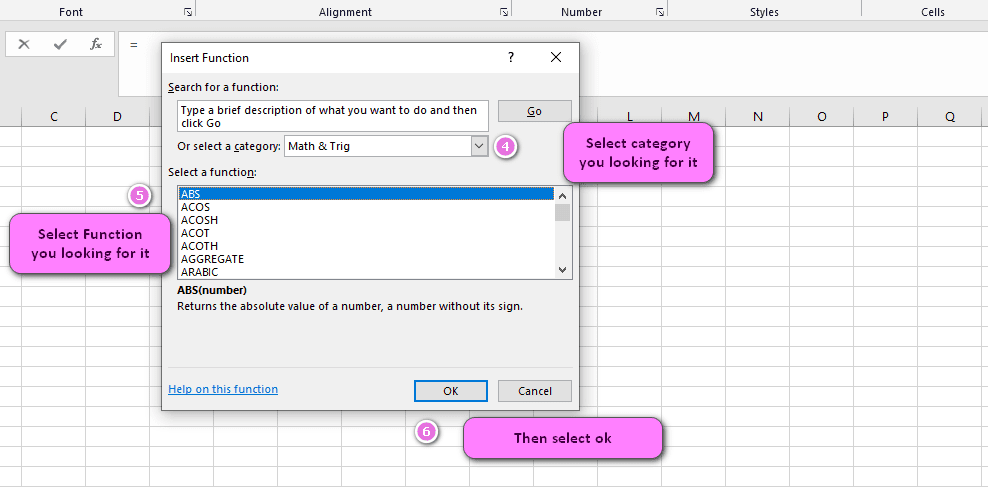What is the SQRT function in Excel?
The SQRT function is one of the math functions of Excel.
It Returns the square root of a number.
We can find this function in Math & trig category of insert function Tab.
How to use SQRT function in excel
- Click on an empty cell (like F5 )

2. Click on fx icon (or press shift+F3)

3. In the insert function tab you will see all functions

4. Select math and trig category
5. Select SQRT function
6. Then select ok

7. In the function arguments Tab you will see SQRT function
8. Number section is the number for which you want the square root.
9. You will see results in the formula result section

Examples of SQRT function in excel
- To calculate the square root of a number in cell A1, use the formula =SQRT(A1).
- To calculate the square root of the sum of two numbers in cells A1 and B1, use the formula =SQRT(SUM(A1:B1)).
- To calculate the square root of a number raised to a power in cell A1, use the formula =SQRT(A1^3).
- To calculate the square root of the absolute value of a negative number in cell A1, use the formula =SQRT(ABS(A1)).
- To calculate the square root of a fraction in cell A1, use the formula =SQRT(1/2).
- To calculate the square root of the product of two numbers in cells A1 and B1, use the formula =SQRT(A1*B1).
- To calculate the square root of the difference between two numbers in cells A1 and B1, use the formula =SQRT(ABS(A1-B1)).
- To calculate the square root of the result of a lookup formula such as VLOOKUP or INDEX/MATCH, use the formula =SQRT(VLOOKUP(“apples”,A1:B10,2,FALSE)).
- To calculate the square root of a nested formula that includes other functions such as SUM and MAX, use the formula =SQRT(SUM(MAX(A1,B1),MIN(B2,C2))).
- To calculate the square root of a dynamic range of numbers, such as the values in column A up to the last row with data, use the formula =SQRT(AVERAGE(A1:INDEX(A:A,MATCH(9.99999999999999E+307,A:A)))).
Example 1:
How to use SQRT function in excel
You can see examples of SQRT function below:

sqrt(1) ----->>>>answer is 1
sqrt(2) ----->>>>answer is 1.41
sqrt(3) ----->>>>answer is 1.73
sqrt(4) ----->>>>answer is 2
sqrt(5) ----->>>>answer is 2.23Excel’s SQRT Function: What It Does and How to Use It
The SQRT function in Excel is used to find the square root of a given number. It returns the positive square root of the number. The syntax for the SQRT function is =SQRT(number). You can use this function in formulas and calculations where you need to find the square root of a number.
Example: To find the square root of 64 using the SQRT function, enter the formula =SQRT(64) in any cell. The result will be 8.
Quick Guide: How to Use Excel’s SQRT Function
To use Excel’s SQRT function, simply select the cell where you want to display the result and type =SQRT(number), where “number” is the value or reference to the cell that contains the value you want to calculate the square root for. The result will be the positive square root of the given number.
Example: To find the square root of the value in cell A1, type =SQRT(A1) in another cell. If the value in cell A1 is 25, the result will be 5.
The Syntax of Excel’s SQRT Function Explained
The syntax of Excel’s SQRT function is =SQRT(number), where “number” is the value or reference to the cell containing the value you want to calculate the square root for. The SQRT function only takes one argument, which must be a numeric value or reference.
Example: To find the square root of 100 using the SQRT function, enter the formula =SQRT(100) in any cell. The result will be 10.
Parameter in Excel’s SQRT Function: Everything You Need to Know
The parameter in Excel’s SQRT function is the numeric value or reference to the cell containing the value you want to calculate the square root for. You can use the SQRT function in formulas and calculations where you need to find the square root of a number.
Example: To find the square root of the value in cell A2 using the SQRT function, enter the formula =SQRT(A2) in another cell. If the value in cell A2 is 36, the result will be 6.
Excel’s SQRT Function and Negative Numbers: Can It Be Done?
Excel’s SQRT function cannot calculate the square root of negative numbers. If you try to calculate the square root of a negative number using the SQRT function, Excel will return the #NUM! error.
Example: To find the square root of -25 using the SQRT function, enter the formula =SQRT(-25) in any cell. The result will be the #NUM! error.
Squaring a Number in Excel: Step-by-Step Guide
To square a number in Excel, you can simply use the POWER function. The POWER function takes two arguments: the base and the exponent. To square a number, you would set the exponent to 2, like this:
=POWER(number,2)
For example, to square the number 5, you would enter the following formula into a cell:
=POWER(5,2)
This will return the result of 25, which is the square of 5.
Excel Formula for Calculating Square Root of a Number: A Comprehensive Explanation
Excel has a built-in function for calculating the square root of a number called SQRT. The syntax for the SQRT function is as follows:
=SQRT(number)
Where “number” is the value for which you want to calculate the square root.
For example, if you want to calculate the square root of 25, you would enter the following formula into a cell:
=SQRT(25)
This will return the result of 5, which is the square root of 25.
How to Use Excel’s Built-in Function to Find the Square Root of Any Number
To use Excel’s built-in function to find the square root of any number, you can simply follow these steps:
- Select the cell where you want to display the result.
- Enter the formula “=SQRT(number)” into the cell, replacing “number” with the value for which you want to calculate the square root.
- Press Enter on your keyboard or click away from the cell to see the result.
For example, if you want to find the square root of 144, you would enter the following formula into a cell:
=SQRT(144)
This will return the result of 12, which is the square root of 144.
Excel’s SQRT Function and nth Roots: Tips and Tricks
Excel’s SQRT function can be used to find not only the square root of a number, but also the nth root of a number. To find the nth root of a number using the SQRT function, you would divide the exponent by n and use that as the argument for the SQRT function.
For example, if you want to find the cube root of 125, you would enter the following formula into a cell:
=SQRT(125^(1/3))
This will return the result of 5, which is the cube root of 125.
SQRT Versus POWER Function: Which One Is Better in Excel?
The choice between using the SQRT function and the POWER function depends on what you are trying to accomplish. If you simply need to find the square root of a number, the SQRT function is the easier and more straightforward option. However, if you need to raise a number to a specific power, such as squaring or cubing a number, the POWER function is the better choice.
For example, if you want to square the number 6, you would use the POWER function like this:
=POWER(6,2)
This will return the result of 36, which is the square of 6.
How to Use Excel’s SQRT Function with IF Statements for Better Results
You can combine Excel’s SQRT function with IF statements to perform conditional calculations based on the result of square root operations. For example, suppose you have a dataset of numbers in column A and want to calculate the square root of each value only if it is greater than 5. You could use the following formula in cell B1:
=IF(A1>5,SQRT(A1),"")
This formula checks whether the value in cell A1 is greater than 5. If it is, the SQRT function calculates the square root of that value. Otherwise, an empty string is returned. You can then copy this formula down the rest of column B to apply it to the entire dataset.
Excel’s SQRT Function and Other Formulas: Combining Them for Greater Efficiency
Excel’s SQRT function can be combined with other formulas to streamline your calculations and reduce the amount of manual work involved. For instance, you can use the SUM function to add up the square roots of a range of cells, like so:
=SUM(SQRT(A1:A10))
This formula calculates the square root of each value in the range A1:A10, and then adds them together to produce a single result. By using SUM in conjunction with SQRT, you can perform complex calculations with minimal effort.
Rounding the Result of Excel’s SQRT Function: Simple Techniques
If you need to round the result of an SQRT function to a specific number of decimal places, you can use the ROUND function. For instance, to round the square root of the value in cell A1 to two decimal places, you could use the following formula:
=ROUND(SQRT(A1),2)
This formula calculates the square root of A1, and then rounds the result to two decimal places. You can adjust the number of decimal places as needed by changing the second argument of the ROUND function.
Formatting the Result of Excel’s SQRT Function: Best Practices
When formatting the result of an SQRT function, it’s important to choose a format that makes the data easy to read and understand. For instance, you might want to use a comma style or currency style to make large numbers more readable. Additionally, you can use conditional formatting to highlight cells with particularly high or low values. By using appropriate formatting techniques, you can present your data in a way that is not only accurate, but also visually appealing and easy to interpret.
Mastering Excel’s SQRT Function with Arrays: Examples and Demonstrations
Excel’s SQRT function can be used with arrays to perform calculations on large datasets with ease. For example, suppose you have two sets of numbers in columns A and B, and you want to calculate the sum of their square roots. You could use the following formula:
=SUM(SQRT(A1:A10)+SQRT(B1:B10))
This formula calculates the square root of each value in columns A and B, adds them together, and then calculates the total sum. By using arrays with SQRT, you can perform complex calculations across multiple datasets and produce highly accurate results.
How to Create a Table of Square Roots in Excel: A Comprehensive Guide
You can create a table of square roots in Excel by using the SQRT function together with the ROW or COLUMN functions. For example, to generate a table of the square roots of the numbers 1 through 10, you could use the following formula in cell A1:
=SQRT(ROW())
This formula uses the ROW function to generate a sequence of numbers from 1 to 10, and then applies the SQRT function to each one. You can copy this formula across row 1 to generate a complete table of square roots.
Creating Charts of Square Roots in Excel: Tips and Tricks
When creating charts of square roots in Excel, it’s important to choose an appropriate chart type that showcases your data effectively. For example, you might want to use a line chart to show how the square root of your data varies over time, or a scatter chart to highlight any correlations between different variables. Additionally, you can use trendlines and other graphical elements to make your charts more informative and visually appealing.
Excel’s SQRT Function in VBA: How to Use It for Your Projects
If you’re working on a VBA project in Excel and need to calculate square roots, you can use the SQR function instead of SQRT. The syntax for the SQR function is identical to that of SQRT, but it may be faster in some cases. For example, to calculate the square root of the value in cell A1 and store the result in B1 using VBA, you could use the following code:
Sub SqrtExample()
Range("B1").Value = Sqr(Range("A1").Value)
End Sub
This code calculates the square root of A1 using the SQR function, and then stores the result in B1.
Excel’s SQRTPI Function: Everything You Need to Know
Excel’s SQRTPI function calculates the square root of a number multiplied by pi. The syntax for the SQRTPI function is as follows:
=SQRTPI(number)
Where “number” is the value you want to calculate the square root of multiplied by pi. For example, to calculate the square root of 25 times pi, you would use the following formula:
=SQRTPI(25*PI())
This formula calculates the square root of 25 times pi, which is approximately equal to 7.957747.
Common Errors When Using Excel’s SQRT Function and How to Fix Them
One common error when using Excel’s SQRT function is the “#NUM!” error, which occurs when you try to take the square root of a negative number. To avoid this error, you can use an IF statement to check whether the input value is positive before applying the SQRT function. Another error is the “#VALUE!” error, which occurs when the input value is not a valid number. To fix this error, make sure that the input value is a numeric value or can be converted to one.

